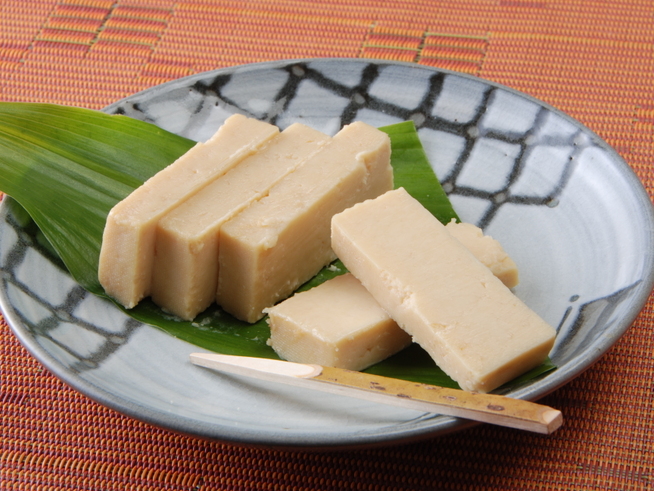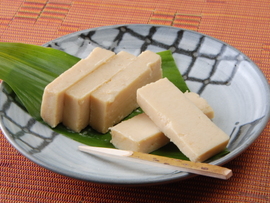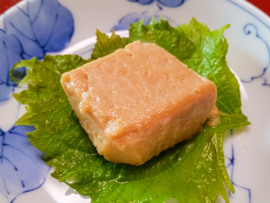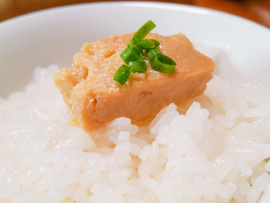
Miso-marinated Tofu

KumamotoMiso-marinated Tofu
Classification (Large)
Agricultural products
Classification (Small)
Processed bean products
Main ingredients used
Tofu, miso, sugar
When using downloaded images, please read the "Terms of Use" and clearly state that the source of the image is "Traditional Foods in Japan" by the Ministry of Agriculture, Forestry and Fisheries.
If the photo credits is stated, please include it as well.
Example of description
of the photo credits
Example of description when the photo credits is not stated
Source: "Traditional Foods in Japan" Ministry of Agriculture, Forestry and Fisheries
Example of description when the photo credits is stated
Source: "Traditional Foods in Japan" Ministry of Agriculture, Forestry and Fisheries
Photo credits:xxx

Photo credits:Kumamoto Prefecture
This image isunavailable.
Region of inheritance
Yatsushiro region, Itsuki region, Gokanosho and surrounding areas, Kuma region
Product overview (special characteristics and types)
Miso-marinated Tofu is made by draining all excess moisture from the tofu by pressing down on it, then alternating the processes of marinating the tofu in miso with a high salt content and spreading sugar over the tofu. A firmer tofu is used since it has to keep at room temperature for a long period of time.
In these regions, particularly unique types of tofu are made. In the Ayugaeri area of Yatsushiro City’s Sakamoto Town, a tofu called “Kazura Tofu” is made by pressing down hard on it with a stone weight during the firming process to drain any excess water. Kazura Tofu is named thus because “Tsutakazura” (the general name for vines) were used to tie up the tofu during transportation, as they could even be suspended and carried due to how firm they were. In addition, Itsuki Village, where the famed folk song “Lullaby of Itsuki” hearkens from, is home to a tofu known as “Kashinoki Tofu” (oak tofu), where plenty of soybeans — four times the usual — is used to make a tofu that has a firm texture as well. These are the types of tofu used in Miso-marinated Tofu.
When it is ready, Miso-marinated Tofu is thinly sliced and eaten over rice or as an accompaniment to alcoholic beverages, in which case it is eaten as-is. The tofu is marinated for approximately half a year and its taste resembles that of uni (sea urchin) or cheese. There is also a version that employs moromi, a type of mash used in the production of fermented products. Currently the main type of Miso-marinated Tofu consumed is low in salt content, and has a silky texture and mellow taste. It is sold as a local specialty in various places all over the prefecture.
History and culture
Miso-marinated Tofu was said to have originated around 800 years ago, when the troops of Heike lost to the clan of Genji, and soldiers fled to the foothills of the Higo mountain range to hide. The fallen soldiers of Heike settled there and introduced the dish to the area.
From a long time ago, soybeans and wheat grown in swiddens (areas of land that have been cleared by cutting and burning) have been used to produce homemade tofu and wheat miso in the mountainous districts of Gokanosho (present-day Izumi Town of Yatsushiro City) and Itsuki Village. In the Ayugaeri region, during Obon, the New Year, and ceremonial functions, two to three families would gather at a house that had a millstone and cauldron to make firm tofu. Firm tofu which employs an abundant amount of soybeans like “Kashinoki Tofu” also exist. Miso-marinated Tofu, which uses these ingredients, was regarded as an important preserved food and protein source in those times, when the land had limited logistics systems and there were no refrigerators.
Production method
Kazura Tofu: Soybeans are softened by immersing them in water before they are ground by a millstone, then poured in water to boil. This mixture is then strained to obtain soy milk, to which bittern is added before being poured into a mold box lined with cloth. To remove excess moisture for the production of firm tofu, a stone weight is placed on the top of the tofu in the mold.
Miso-marinated Tofu: Excess moisture is pressed out of the tofu before it is marinated in miso with a high salt content. If it is made at home and the miso marinade, “Misodoko,” is already available, the tofu is taken out when it is deemed ready as per the family’s preference since its flavor deepens with each day it is marinated.
Conservation and succession efforts
Miso-marinated Tofu (and also Moromi-marinated Tofu) are sold at Michi no Eki roadside rest stops, product promotion centers, online stores, and more. There has been a decline in the number of people who make Kazura Tofu but foods that make use of Kazura Tofu can be found at its place of origin, the Ayugaeri region, where there are Ayugaeri-life research groups and local tofu makers selling the products.
Main consumption method
The Miso-marinated Tofu is thinly sliced and had over rice or as a pairing for wine, shochu, or other alcoholic beverages. Having it with wasabi or soy sauce, according to preference, is also a delicious option. The tofu may also be cut up finely and mixed with rice to form onigiri rice balls, or put in salad, thus enjoyed as an ingredient.


